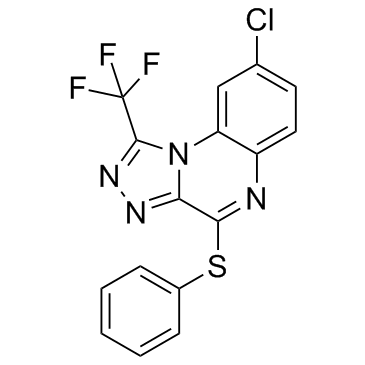| Description |
R-7050 is a tumor necrosis factor receptor (TNFR) antagonist with greater selectivity toward TNFα.
|
| Related Catalog |
|
| Target |
TNFα
|
| In Vitro |
R-7050 is a potent and fully reversible hit with greater selectivity toward TNFα. In TNFα-induced intercellular adhesion molecule 1 (ICAM-1) expression, R-7050 inhibition potency (EC50=0.63 μM) is 2- to 3-fold greater than EC50 for IL-1β-induced ICAM-1 expression (EC50=1.45 2 μM). R-7050 inhibits phosphorylation of both the JNK pathway (MKK4, JNKs, and ATF2) and p38 pathway (MKK3/6, p38, and MAPKAP2)[1]. R-7050 is a cell-permeable triazoloquinoxaline compound that selectively inhibits TNF-α induced cellular signaling. Unlike biologic TNF inhibitors (e.g. Infliximab, Etanercept, Adalimumab) that directly bind TNF-α and function as decoy receptors, R-7050 does not affect binding of TNF-α to TNFR. In contrast, R-7050 selectively inhibits the association of TNFR with intracellular adaptor molecules (e.g. TRADD, RIP), limits receptor internalization, and prevents subsequent cellular responses after TNF-α binding[2].
|
| In Vivo |
R-7050 (6 mg/kg) reduces Evans blue extravasation to 28.7±5.9 μg and 30.3±1.9 μg Evans blue/g brain tissue when administered at 0.5 h or 2 h post-ICH, respectively (p<0.05 and p<0.01 vs ICH, respectively; not significantly different from sham). Brain water content, a measure of brain edema, increases from 75.6±0.3% in sham-operated mice to 81.5±0.5% at 24h post-ICH (p<0.05 vs. sham). 6, 12, or 18 mg/kg R-7050 reduces brain water content to 78.5±0.3%, 78.3±0.3%, or 79.3±0.5%, respectively (all treatments p<0.05 vs. ICH; treatments not significantly different from each other). Notably, mice treated with 18 mg/kg exhibit a reduction in general activity/locomotion. As is observed with Evans blue extravasation, R-7050 (6 mg/kg) significantly reduces brain water content after ICH. Administration of R-7050 at 0.5h or 2h post-ICH attenuates brain water content to levels observed in sham-operated mice (p<0.05 vs ICH, not significantly different from sham)[2].
|
| Animal Admin |
Mice[2] A mouse collagenase model of ICH is utilized. Briefly, male CD-1 mice (8-10 weeks old) are placed into a stereotactic frame and a 0.5 mm diameter burr hole is drilled over the parietal cortex, 2.2 mm lateral to the bregma. A 26-gauge Hamilton syringe, loaded with 0.04 U of bacterial type IV collagenase in 0.5 μL saline, is lowered 3 mm deep from the skull surface directly into the left striatum. The syringe is depressed at a rate of 450 nL/min and left in place for several minutes after the procedure to prevent solution reflux and excess diffusion. Sham animals undergo the same surgical procedure, except that saline is stereotactically injected rather than collagenase. After the syringe is removed, bone wax is used to close the burr hole, the incision is surgically stapled, and mice are kept warm until recovery of the righting reflex. R-7050 (6-18 mg/kg) is administered via intraperitoneal route at the time of injury or up to 2 h post-ICH[2].
|
| References |
[1]. Gururaja TL, et al. A class of small molecules that inhibit TNFalpha-induced survival and death pathways viaprevention of interactions between TNFalphaRI, TRADD, and RIP1. Chem Biol. 2007 Oct;14(10):1105-18. [2]. King MD, et al. TNF-alpha receptor antagonist, R-7050, improves neurological outcomes following intracerebralhemorrhage in mice. Neurosci Lett. 2013 May 10;542:92-6.
|


